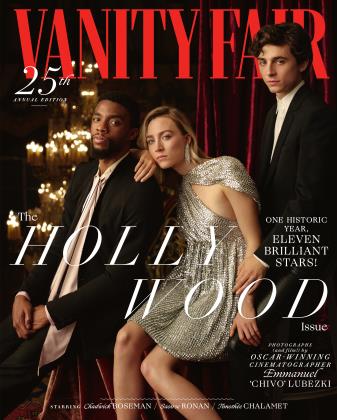Sign In to Your Account
Subscribers have complete access to the archive.
Sign In Not a Subscriber?Join NowPOWER HOUSE
Vanities/Legends
Keziah Weir
In the first moments of Giorgio Armani's favorite film, Alfred Hitchcock s 1946 romantic thriller, Notorious, a young woman exits a Miami courtroom through a gauntlet of flashbulbs. Played by Ingrid Bergman, the woman is statuesque, her expression enigmatic, her ensemble aesthetically impeccable: a creamy jacket coupled with a wide hat and high-necked blouse, both black and dotted with glittering stones.
It's clear why this movie, a paean to elegance and outsize personalities, occupies a place in the heart of 84-year-old Mr. Armani (as he's called by everyone in his industry), a self-described film buff who transformed awards-season style by eschewing the trendy and provocative in favor of fresh sophistication. Even a marginally perceptive viewer will note the congruence between Bergman's outfit and early iconic Armani looks, all iterations of what would come to be known as "power dressing": Diane Keaton's assertively elegant blazer in 1978; Michelle Pfeiffer's luxe suit in navy velvet a decade later; Jodie Foster's silk jacket and beaded trousers in 1992, the only pop of color a crimson AIDS-awareness ribbon pinned to her lapel. The metonymic red carpet may be a far cry from a Florida courthouse, but the demand for flawlessness is about on par.
FOR DETAILS, GO TO VF.COM/CREDITS
Since the brand's earliest days, Armani has enjoyed a happy entanglement with Hollywood. The designer—who draws inspiration from Italian neo-realists to American Westerns; from Hitchcock to Martin Scorsese (a close friend)—has outfitted 200-plus movies (including American Gigolo and The Wolf of Wall Street) and a compounded sum of awards-circuit appearances. He's even credited with creating the role of the stylist by installing a savvy in-house celebrity liaison, Wanda McDaniel, at his Rodeo Drive boutique, which opened in 1988. His promise to those who don his designs, whether it's Viola Davis in a dramatic red gown, or loyalist Cate Blanchett in a host of confections: "She will not regret what she is wearing when she looks at pictures of herself in the press the next day. Or even next year."
It's now more than four decades since Armani's first Oscars carpet. That time was "an era of transition," Armani says, "and today there are similarities." Once again, the red carpet has become a forum for debate, where Time's Up pins abound and each gown serves as an amplification of the woman inside it rather than the main event. Which is, he adds, "what I have always believed is the secret of great red-carpet dressing."
Power-dressing, today, reflects a particular look that was fashionable in the 80s. "But for me clothes have always had power," says Armani. "The power to make people feel they are at their best." One thinks of the Mona Lisa smile that settles onto Ingrid Bergman's face as she and her perfect clothes sail through the cameras and questions. "Armani is still about 'power dressing,' " the designer says. "Dressing to empower."
ARMANI AT THE OSCARS
Four glorious decades of red-carpet style
1970s
1980s
1990s
1990s
2000s
2010s
 View Full Issue
View Full Issue
Subscribers have complete access to the archive.
Sign In Not a Subscriber?Join Now